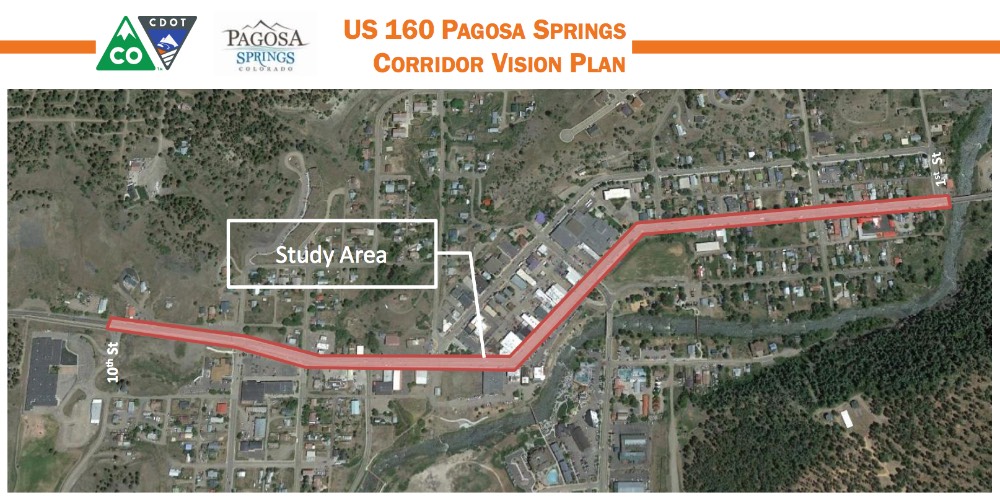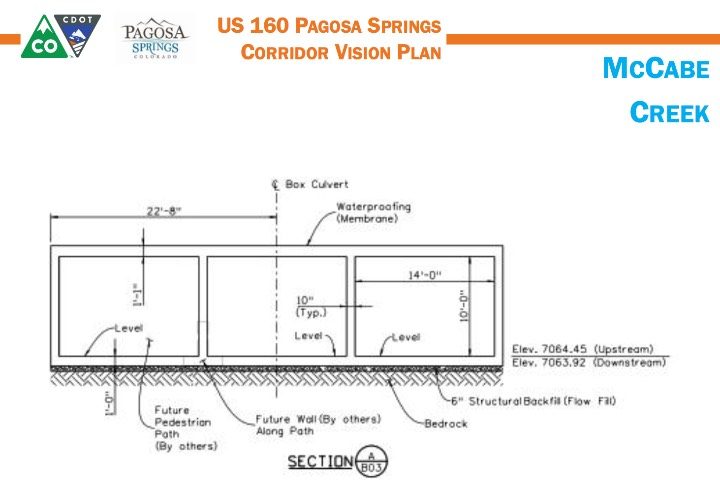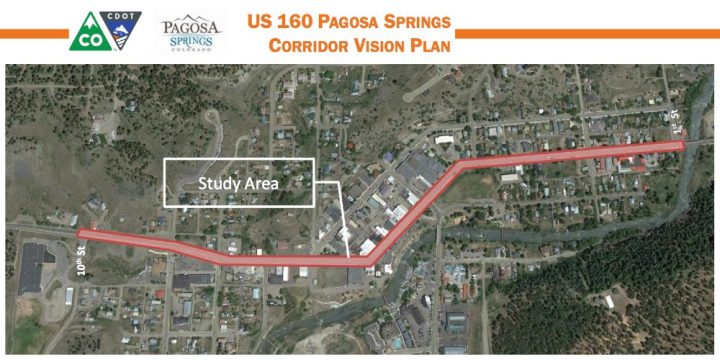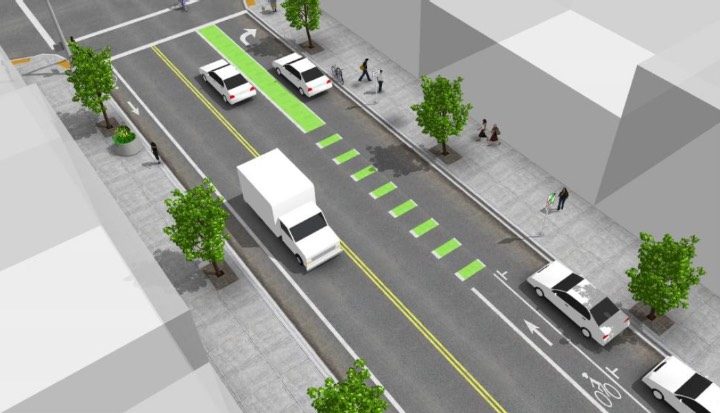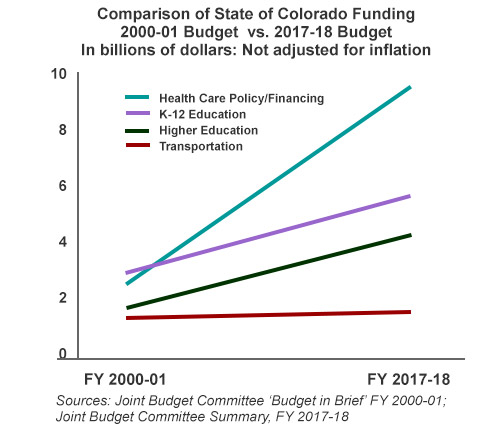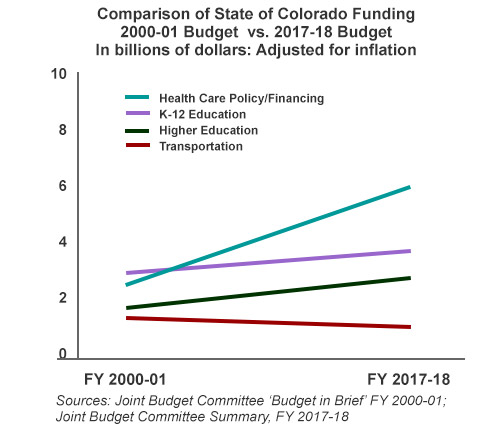Following our rehearsal yesterday afternoon for the ‘Acoustic Duets’ concert, my music partner Greg Milioto mentioned one of his current concerns, regarding Archuleta County.
“Our infrastructure is totally falling apart,” he opined, referring to our local roads. His tone implied that he expected the disintegration to continue indefinitely.
This is, of course, a common attitude in America: that we appear to be on a downhill path, in terms of government-maintained infrastructure.
A person could have easily walked away with a similar concern, following the presentation by the Colorado Department of Transportation to the joint Town Council and Board of County Commissioners on February 26. The folks from CDOT ran through a Powerpoint slideshow that focused on several items: the reconstruction of the downtown stretch of Highway 160, the proposed McCabe Creek bridge, and possible intersection improvements at Pinon Drive related to a proposed development across the highway from the Wyndham Resorts headquarters and the Pagosa Lodge.
CDOT had done a recent study of intersections and corridors in Region 5 — the 15 counties of Archuleta, La Plata, Montezuma, San Juan, Dolores, Montrose, San Miguel, Ouray, Mineral, Rio Grande, Chaffee, Saguache, Conejos, Costilla, and Los Alamos — and had identified 72 locations where traffic accidents seemed to warrant expensive (or maybe less expensive) improvements. That project list was ‘scaled down’ to the top 15 projects.
To create the scaled-down list, the number of crashes per million vehicles miles were compared across the region, and were compared to “the number of crashes we would expect to see.”
“Which is not to say crashes are unimportant, but we only have so much funding, so we have to find a way to prioritize things.”
Four projects in Archuleta County made the cut. The Piedra Road intersection. The Pagosa Boulevard intersection. Pinon Causeway.
And the Downtown Corridor.
As far as I could tell, the general condition of Highway 160 — dotted as it is with potholes of various sizes during the winter months — was not specifically discussed as a problem. But the downtown stretch between 10th Street and 1st Street, specifically, was the main item of conversation.
We were told about a plan to replace the failing asphalt highway between 8th Street and 2nd Street with a new concrete surface. The reconstruction, as proposed on February 26, 2019, would include new sidewalks, wider sidewalks, new crosswalks, new medians in the central business district, and pedestrian ‘bulb-outs’ that might make pedestrian crossings less treacherous. CDOT would re-stripe the downtown stretch from four lanes down to two lanes the highway into a two-lanes, with a ‘bike lane’ running through the downtown section. (We note that the bike lanes would not connect to anything beyond 8th Street on the west end, or beyond 1st Street on the east end.)
The number of on-street parking spaces available downtown would be reduced from about 314 to about 300. They calculated a total of about 917 downtown spaces, including off-street parking. CDOT noted that, if Pagosa Springs continues to grow its population, and those new residents continue to drive cars rather than riding bikes, the parking situation downtown will only get worse in the future. They figured that downtown would need about 1270 spaces by 2041.
2041 is the year they believe the current highway configuration through downtown will cease to operate ‘acceptably.’
CDOT recognizes that the McCabe Street culverts that run under Highway 160 near Sixth Street pose a serious problem — failing as they are, and undersized as they are for a major flood event — but again, we have that lack of funding situation.
I found the discussion slightly odd, because I’d heard so much of this same discussion three years ago, when CDOT was planning the current re-striping pattern for downtown. At that time, Mike McVaugh, then-director for Region 5, described a similarly expensive project, and noted that funding was an ongoing problem for CDOT.
He suggested that local taxpayers would have to kick in some money, if they really want a quality highway running through downtown. Apparently, things haven’t gotten better since 2016. The downtown reconstruction is still a dream.
Highways are not exactly a growth industry at this point in Colorado’s history, even though the population of the state has increased by about 26 percent since 2001. During that same period, Colorado’s state budget for health care has increased by about 223 percent; state funding for K-12 education has increased by about 95 percent. Not adjusted for inflation.
The CDOT budget increased by about 14 percent. Not adjusted for inflation.
Here’s a little chart I threw together a while back, to compare the Colorado funding for four budget items in fiscal year 2000-01 and fiscal year 2017-18. It’s shown as a straight line, and doesn’t account for the budgetary “ups and downs” caused by two recessions and recoveries during that period. But it gives a sense of the place CDOT has occupied in the priorities of Colorado state legislators over the past decade and a half. Not adjusted for inflation.
Basically, funding for our state highways has been “flat”… while other social needs have seen significant increases in state spending. As we mentioned above, the state’s population has increased by about 26 percent since 2000. A million more people using the highways… but basically no additional money to maintain those highways.
The picture is slightly more depressing if we were to adjust the graph to account for the 37% inflation we’ve experienced since 2000. The amount of monetary value we are assigning to our state highways is actually much less than it was at the turn of the 21st century:
Last November, Colorado voters turned down two proposals to increase the funding for our state transportation department. I can imagine the folks at CDOT were disappointed by that vote, but probably not surprised, considering they’ve been getting the same dismissive treatment from the Colorado General Assembly for the past two decades.
Our local Board of County Commissioners recently announced their intention to pull money out of the Archuleta County Road & Bridge Fund to help pay for a very large, new County jail.
And it’s not just Colorado that seems to dislike maintaining infrastructure. We will close Part One with a little quote from President Donald Trump, as shared by CNN.com back in June, 2017.
“We will create the first class infrastructure our country and our people deserve. It’s time to rebuild our country to bring back our jobs.”
I wonder how he’s doing with that?

